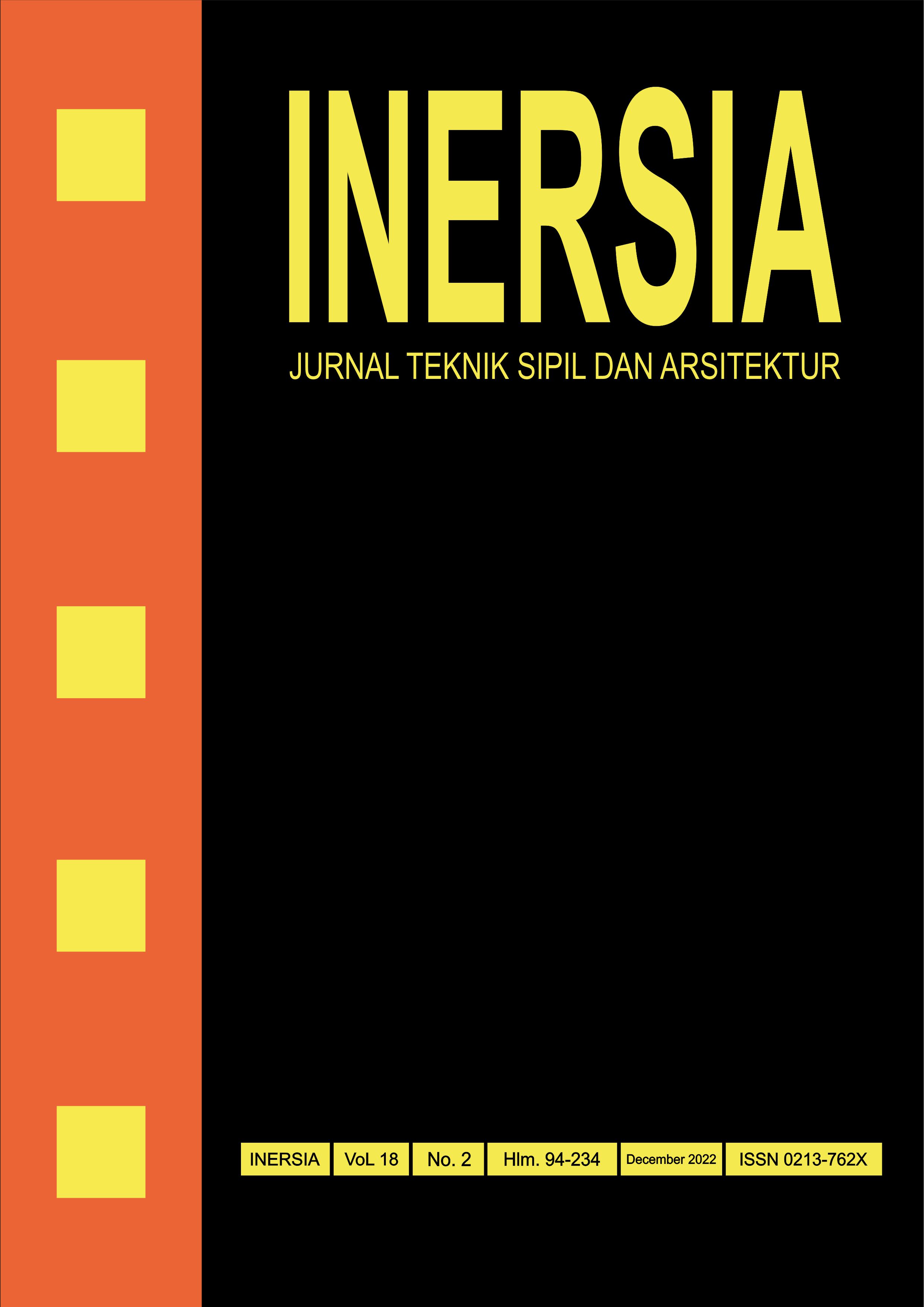Application of Walkability Principles of Pedestrian Path in Supporting the Green City Concept (Case of Parasamya Street Corridor, Sleman Regency)
DOI:
https://doi.org/10.21831/inersia.v18i2.49247Keywords:
walkability, pedestrian path, green cityAbstract
The convenience of pedestrian paths is an essential aspect that needs to be studied in urban planning. Along with the increasing use of motorized vehicles, facilities for pedestrians must also be considered to minimize the acquisition of pedestrian space. Walkability is a concept that prioritizes safety, comfort, and being able to provide friendliness to its users. The provision of facilities on pedestrian paths is also one of the supporting aspects in realizing a green city because the green lanes found on pedestrian paths have benefits such as circulation, city aesthetic functions, and maintaining urban air quality. The government area of Sleman Regency is an integrated office area that has begun to improve the pedestrian path, including Parasamya Street. This study aims to examine the application of the walkability principle on Parasamya Street, Sleman Regency, as an effort to support the concept of a green city. The research method used is qualitative through observation, documentation, mapping, and interpreting the results descriptively by comparing the existing conditions with theories and regulations related to the concept of pedestrian paths and the concept of a green city. The results obtained from this study are that the application of the walkability principles on Parasamya Street can support the concept of a green city which is indicated by the fulfilment of infrastructure facilities, including ecological comfort. Things that need to be improved are an equal distribution of facilities for the disabled and the improvement of crossing facilities.
References
C. D. Aguspriyanti, "Green Corridors: Potensi Peningkatan Ruang Terbuka Hijau Publik Ramah di Kota Padat (Studi Kasus Kota Malang)," Jurnal Arsitektur ZONASI, vol. 4, no. 2, pp. 234–345, 2021, doi: 10.17509/jaz.v4i2.33439.
M. D. Setyowati, "Pemanfaatan Pedestrian Ways di Koridor Komersial di Koridor Jalan Pemuda Kota Magelang," Jurnal RUAS, vol. 15, no. 1, pp. 13–22, 2017.
F. Lestari and G. Pramita, "Identifikasi Fasilitas Pejalan Kaki di Kota Bandar Lampung," Journal of Infrastructure in Civil Engineering (JICE), vol. 1, no. 1, pp. 27–32, 2020.
Kementerian Pekerjaan Umum, "Pedoman Perencanaan, Penyediaan, dan Pemanfaatan Prasarana dan Sarana Jaringan Pejalan Kaki di Kawasan Perkotaan," Menteri Pekerjaan Umum Republik Indonesia, vol. 2013, 2014.
V. D. Wowor, V. A. Kumurur, and L. I. R. Lefrandt, "Urban Walkability di Kota Manado (Studi Kasus: Kec. Mapanget)," Jurnal Spasial, vol. 6, no. 1, pp. 178–186, 2019.
M. Sofwan and M. H. Tanjung, "Evaluation Study Of Walkability Index In Central Business District (CBD) Area, Pekanbaru City," Journal of Geoscience, Engineering, Environment, and Technology, vol. 5, no. 3, pp. 175–185, 2020, doi: 10.25299/jgeet.2020.5.3.4181.
A. M. Sari, D. F. Sari, and S. Wibawani, "Penerapan Konsep Walkability Dalam Mendukung Kota Surabaya Sebagai Kota Metropolitan yang Produktif dan Berkelanjutan," Public Administration Journal of Research, vol. 2, no. 3, pp. 287–303, 2020.
A. T. M. Uak, "Evaluasi Konsep Ramah Pejalan Kaki Pada Pedestrian Malioboro Dengan Pendekatan Konsep Walkability," Jurnal Arsitektur ARCADE, vol. 4, no. 1, pp. 29–34, 2020.
H. Krambeck, "The Global Walkability Index," Massachusetts Institute of Technology, 2006.
G. M. Wijayanti, A. Agustina, and R. Sulistyorini, "Kualitas Walkability Jalur Pejalan Kaki Pada Kawasan Bisnis Simpur Center dan Sekitar," Kacapuri, vol. 3, no. 1, pp. 116–123, 2020.
I. W. Agustin, "Penerapan Konsep Walkability Di Kawasan Alun-Alun Kota Malang," Jurnal Pengembangan Kota, vol. 5, no. 1, p. 45, 2017, doi: 10.14710/jpk.5.1.45-57.
H. Mustikawati and N. Widyawati, "Evaluasi Aspek Fisik dan Kenyamanan Jalur Pedestrian Melalui Analisis Persepsi Masyarakat di Jalan Diponegoro Salatiga," Jurnal Lanskap Indonesia, vol. 11, no. 1, 2019.
L. Suminar and P. A. Sari, "Identifikasi Fasilitas Pejalan Kaki di Koridor Jalan Affandi Yogyakarta Dalam Mendukung Konsep Walkability," Jurnal Arsitektur ZONASI, vol. 4, no. 3, pp. 276–287, 2021.
R. Syafriharti, B. Kombaitan, I. Syabri, and P. Dirgahayani, "Perceived neighborhood walkability and walking for particular purposes among motorcyclists in Bandung City, Indonesia," Journal of Engineering Science and Technology, vol. 16, no. 6, pp. 4573–4581, 2021.
R. Rafiemanzelat, M. I. Emadi, and A. J. Kamali, "City sustainability : the influence of walkability on built environments," Transportation Research Procedia, vol. 24, pp. 97–104, 2017, doi: 10.1016/j.trpro.2017.05.074.
N. Tanan and G. B. Suprayoga, "Fasilitas Pejalan Kaki Dalam Mendukung Program Pengembangan Kota Hijau," Jurnal HPJI, vol. 1, no. 1, pp. 17–28, 2015.
A. Susetyaningsih, I. Farida, and A. Zhafirah, "Optimization of utilization pedestrian trails and green lines in the city," J Phys Conf Ser, vol. 1402, no. 2, pp. 1–5, 2019, doi: 10.1088/1742-6596/1402/2/022015.
C. Fandeli and Muhamad, Pembangunan Kota Hijau. Yogyakarta: Gadjah Mada University Press, 2020.
Ahmad Syarifudin, "Pemkab Sleman Kembali Tata Jalur Pedestrian." https://jogja.tribunnews.com/2021/10/25/pemkab-sleman-kembali-tata-jalur-pedestrian (accessed Jan. 01, 2022).
Downloads
Published
How to Cite
Issue
Section
License
Authors who publish with INERSIA journal agree to the following terms:
- Authors retain copyright and grant the INERSIA journal right of first publication with the work simultaneously licensed under Creative Commons Attribution License (CC BY 4.0) that allows others to share the work with an acknowledgment of the work's authorship and initial publication in this journal.
- Authors can enter into separate, additional contractual arrangements for the non-exclusive distribution of the published version of the work (e.g., post it to an institutional repository or edit it in a book), with an acknowledgment of its initial publication in this journal.
- Authors are permitted and encouraged to post their work online (e.g., in institutional repositories or on their website) before and during the submission process, as it can lead to productive exchanges, as well as earlier and greater citation of published work.

INERSIA by https://journal.uny.ac.id/index.php/inersia was distributed under a Creative Commons Attribution 4.0 International License











